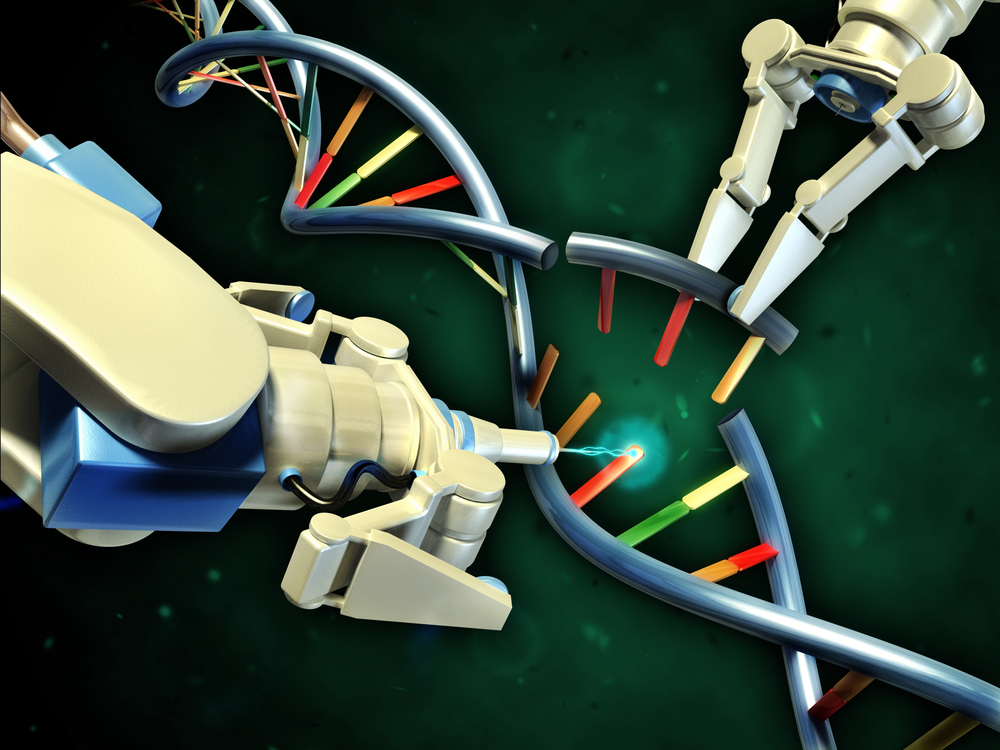
When interrupting is good: genetic hiccups that protect against Huntington's disease
Multiple teams find small differences in the 'CAG repeat' bit of the Huntington's disease gene. They don't directly change the huntingtin protein, but do alter the age of symptom onset. What's behind this enigma and what does it mean for patients?

Multiple new studies have identified what may be the most important new fact about the genetics of Huntington’s disease since the gene was discovered in 1993. At least two research groups around the world simultaneously report that a tiny genetic hiccup in the HD gene has a big impact on HD symptoms.
What’s CAG and why do we care about it?
Huntington’s disease is caused by a single mutation in a single gene. Because of its relationship to HD, we usually refer to it as the HD gene, though scientists formally refer to it as HTT. Everyone has two copies of the HD gene – one each inherited from mom and dad.

Each gene is a recipe – a set of instructions on how to make a protein. Our genes are written in the language of DNA, which uses four chemical letters that scientists abbreviate A, T, G and C. If you zoomed way into a cell and looked at the DNA you wouldn’t actually see these letters, but they help scientists understand and decode the language of genes.
Very near the beginning of the HD gene is a long, repetitive, stretch of the DNA letters C-A-G. Even in people without HD, this sequence repeats itself, on average around 17 times.
CAG size is important for HD onset
In every person destined to develop HD, this stretch of CAGs in DNA is longer than normal. The average HD patient has something like 44 repeats, and some have many more. In general, the more CAGs found in a person’s HD gene, the sooner we would expect them to develop HD symptoms – though this varies a lot between individual patients.
Extremely long CAG repeats give a clear example of this effect. Very long repeats (over about 65) tend to cause very early onset of HD, or juvenile-onset Huntington’s disease (JHD).
Very recently, two separate research groups published the same startling discovery about these CAG repeats. Before we describe their findings, we have to get just a little bit into the weeds.
CAGs and glutamines
The first thing to understand is that the protein-making instructions in DNA work in a very specific way. The DNA has a 4-letter alphabet: A, C, G and T. Proteins, on the other hand, are made from long strings of building blocks called amino acids. There are twenty different amino acids to choose from, like twenty differently-shaped beads that can be threaded onto a string one by one in any order.
To get from 4 letters in the genetic alphabet, to twenty amino acids to choose from in the protein-making world, our cells have a rule that DNA is interpreted in 3-letter chunks. For example, C on its own doesn’t mean anything, and nor does CA. But CAG is an instruction to add the building block called glutamine to the protein that’s being built.
Because of all this, there is a direct correspondence between how many CAG repeats someone has in their HD gene, and the number of glutamines in the resulting protein, called huntingtin. Someone who inherited a CAG repeat of 42 from their HD-affected parent should make HD proteins with 42 sequential glutamines. We think this is why bigger CAG repeats cause HD symptoms to emerge earlier: more CAGs in the gene means more glutamines in the protein. We don’t know how exactly, but this seems clear.
OK, easy enough. DNA is interpreted three letters at a time to build proteins. Each CAG in the gene causes one glutamine to be added to the protein. And more glutamines is bad!
But wait, it gets weirder!
Reading the DNA three letters at a time like this comes with a snag: there are more 3-letter combinations than we need. There are sixty-four combinations, in fact – but only twenty different amino acids.

Many amino acids therefore have multiple three-letter genetic codes that result in the same one being added to the growing protein. For glutamine – the important amino acid in HD – CAG is the most famous three-letter sequence that corresponds to glutamine, but CAA does exactly the same thing, working just as well as CAG as an instruction to add a glutamine to the protein.
This matters, because close investigation shows that in the vast majority of people, CAA and CAG both occur close together in the HD gene. What we often call the HD gene’s “CAG tract” usually also includes a single “CAA” interruption. Because both CAG and CAA correspond to glutamine, this hasn’t seemed particularly important, and until now, researchers haven’t paid much attention to this little detail.
Let’s see if you are any different! Can you find the CAA interruption in this CAG tract?
CAG-CAG-CAG-CAG-CAG-CAG-CAG-CAG-CAG-CAG-CAG-CAG-CAG-CAG-CAG-CAG-CAG-CAG-CAG-CAG-CAG-CAG-CAG-CAG-CAG-CAG-CAG-CAG-CAG-CAG-CAG-CAG-CAG-CAG-CAG-CAG-CAG-CAG-CAG-CAG-CAA-CAG.
Did you catch it? It’s just before the final CAG.
Genetic testing of CAG size
When HD family members undergo a genetic test to determine whether they are destined to develop HD or not, the lab measures what we call their CAG size. But through a quirk of the way the test is done, it can’t actually pick up these little CAG interruptions.
That’s because the test doesn’t actually read the genetic information directly. Instead, the length of the stretch of DNA containing the CAG tract is measured precisely. That tells us the size of the CAG tract – but crucially, not whether it contains that CAA interruption just before the end.
Until now, we haven’t really had any reason to be concerned about this, but the new findings suggest we should probably start paying attention to the actual sequence of this region.
New findings – GEM-HD
Very recently, multiple groups around the world have observed a very surprising thing. First, the GEM-HD consortium – previously covered on HDBuzz – is a team of researchers interested in understanding what genetic differences in HD patients contribute to symptom onset or progression.
The new publication from the GEM-HD crew describes an analysis of over 9,000 HD patients participating in the ENROLL-HD study. This analysis revealed that the normal CAA interruption near the end of the HD gene’s CAG tract was occasionally missing. This occurred about once in every three hundred people.
People who were missing this interruption, and therefore had only “pure” CAG’s in their HD gene, had significantly earlier onset of HD symptoms than we would predict.

At the same time, the group detected another very rare variation that appeared to do the opposite, and actually delayed the onset of symptomst. This quirk was seen in about one in a hundred people. These folks actually had two CAA interruptions in their CAG tract, rather than the more common single CAA.
The effects of these two rare genetic variations tell a very compelling, if very surprising, story. Seeing both a bad and good version of the variation suggests this effect is real. It also means that a lot of the variation we see between HD patients could be influenced not by the length of the CAG length, but on how ‘interrupted’ it is.
What’s spooky about this is that whether there’s a CAA or a CAG in the HD gene, the cell will build the same protein by adding the same glutamine building block. But if the protein is the bad guy, as most researchers still believe, why does it matter whether that glutamine came from a CAA or a CAG in the gene?! We’ll come back to that shortly.
Like every piece of science, this finding needs to be repeated and validated. But if it’s found to be correct, it has very important impacts on how we think about HD.
New findings – UBC
Luckily, we didn’t have to wait long for confirmation, because another study led by Michael Hayden, at the University of British Columbia, was released at the same time as the GEM-HD study. This was a totally independent investigation carried out in Hayden’s lab, which houses a very large bank of DNA samples from HD families.
The UBC researchers found sixteen people whose CAG repeat was missing that CAA interruption. These folks developed HD symptoms quite a bit earlier than one would expect – maybe as much as decades earlier, based on their traditionally-measured CAG size.
Next, they examined how common this loss of repeat was, in a unique population of HD mutation carriers.
Some people who inherit a CAG size between 36 and 38 develop HD, but others survive to old age without any symptoms. Hayden’s database of HD family DNA includes 45 people who inherited a CAG size of 36, 37 or 38. Fifteen of these people already had HD symptoms, and thirty did not. And strikingly, among the people with these very low CAG sizes and HD symptoms, a majority of them were missing the CAA interruption.
Remember, in general, lacking the CAA is very rare – so the fact that so many people with short CAG counts and HD symptoms are missing it, is very unlikely to be due to chance. It strongly implies that missing the CAA somehow accelerates the onset of HD.
But how?
Having two renowned research groups make simultaneous discoveries like this is really exciting. It suggests that we need to start thinking about how HD works in a slightly different way.
Remember that CAG and CAA in the gene both instruct cells to add a glutamine when building the protein. That means that for any given length, the huntingtin protein is totally identical, whether or not the CAG tract has a CAA interruption.

Logically, the explanation must lie in the DNA, not the protein – and it’s probably related to the curious tendency of CAG tracts to grow over time in certain cells.
We know that after death, the brains of Huntington’s disease patients contain some cells with much larger CAG counts than expected, compared to the CAG length measured in blood tests done when they were alive. It’s still not clear why, but evidence from recent genetic studies suggests that this is down to long stretches of repetitive DNA being difficult to repair when they get damaged.
Our DNA frequently experiences wear-and-tear from things like UV radiation. This causes little nicks and breaks from time to time, and our cells have a whole bunch of machinery for repairing this damage, to prevent harmful changes to our genes.
It seems the long stretch of CAGs confuses the machinery, and occasionally extra CAGs get added during the repair process. That lengthening of the CAG does produce a protein with more glutamines, which is expected to be more harmful.
It’s possible – but not yet proven – that the presence of a CAA interruption among the CAGs makes it easier for the DNA repair machinery to do its job more accurately, perhaps by keeping the two DNA strands better lined up when breakages occur, or by giving the repair equipment something to grab onto. And when the CAA is missing, it seems lengthening of the CAG tract is more likely to occur. Ultimately this means some cells will produce huntingtin proteins with more glutamines, which are more harmful.
Crucially, this expansion wouldn’t necessarily be detectable by measuring the CAG tract in blood cells. There may just be some people with, say a CAG count of 44 on the blood test, who have some brain cells with much longer repeats, because their DNA is harder to repair accurately. Others with a CAG count of 44 would not have much expansion of the CAG in the brain. And that difference between people may be down to the presence or absence of the CAA interruption.
What does this mean for HD family members?
For now, this research is just a scientific finding. It’s an unusually solid one, since it’s been independently reported by two different research teams. In fact, a reliable source tells us a third major team has also reproduced the funding in another patient cohort, and has additional data to flesh out the finding. That team’s work has been submitted for publication in a scientific journal and is currently under peer-review.
The sequence changes the researchers found that modify the age of onset of HD symptoms are really rare – only a very small number of HD family members carry them. That’s why it took a pool of thousands of DNA samples from HD patients to find them at all.
In the future, as we understand these changes better, it may be that genetic testing procedures need to be updated to include sequencing people’s CAG tracts one letter at a time, rather than just measuring the length. But for now, the most important impact of this research is that it sends researchers back to the lab to better understand the impact of these little genetic quirks. While it’s not clear what we’ll find, we do know that this research helps us understand HD much better and might point to new treatment approaches.
These new findings really show the value of research participation by HD families. None of the thousands of people who provided their DNA and other information knew that these important results would emerge. It’s only by participating in studies like ENROLL-HD that we’re able to set the stage for truly unexpected findings like these ones.
Learn more
Sources & References
For more information about our disclosure policy see our FAQ…


